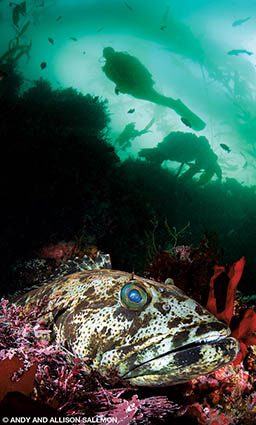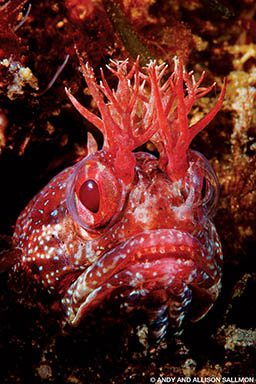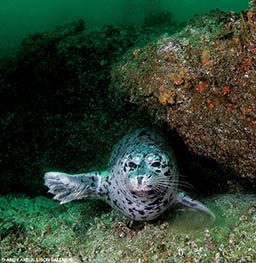I’ll never forget my first visit to San Miguel Island. We anchored over a pinnacle on flat seas under a sunny sky. The captain locked eyes with each diver as he spoke of our good fortune to be at this remote site on such an otherworldly day and cautioned us that conditions could deteriorate at any time. I recall clear, blue water and a reef sumptuous with invertebrate life, the likes of which I’d never encountered before in California. I also remember the sudden onset of a ripping current that made it impossible to get back to the anchor line and deep gratitude for the 7-foot surface marker buoy I was carrying. Feelings of elation, reverence and a little relief permeated the boat as we headed for the mainland. I often remember that day, especially when I am on a boat hoping to dive Miguel. I think of it wistfully because after that visit, despite numerous attempts to return, it took me seven years to dive there again.

San Miguel Island is a tough place. It’s tough to get there, tough to stay there and tough to dive there. The northern- and westernmost of the California Channel Islands, it lies so close to Point Conception (26 miles) that it’s constantly battered by storms from the northwest. The tiny island itself offers little protection; with an area of 14 square miles and a maximum height of only 831 feet, swell and gusts wrap heartily around its rocky, treeless perimeter. Fogbanks and mist are so common that their absence usually indicates wind — and the boat’s imminent departure. Bathed by the cold California Current, the island’s ocean waters are regularly several degrees lower than those encountered in the rest of Channel Islands National Park. But as you might have guessed, the isolation and chilly water are the draw — this magical combination supports a trove of north-meets-south marine abundance that is unique in California.
It’s because of San Miguel that we’re lugging mountains of dive and photo gear down a dock in the middle of the night. The forecast isn’t great, and San Miguel is not a good place to visit just to say you’ve been there. But our companions’ fixed eyes and set jaws reveal that we’re among like-minded divers. The captain and crew make no promises as we depart the harbor, and the mood is pessimistic. But when the passengers begin to stir a few hours later, the ocean is calm. Before long we’re gearing up to dive one of Miguel’s prettiest sites.
Wyckoff Ledge* is a simplistic name for the elaborate network of meandering walls and boulders that make up one of San Miguel’s signature dives. We descend to a ledge at 60 feet, and the initial blast of color — emerald-green water, pink and orange anemones, blue schooling rockfish — greets me as shockingly as the temperature, a chilly 49°F. We make our way through lush kelp, photographing cabezon and losing a stare-down with a lingcod so large that my dive buddy writes, “Linglog!” on his slate. Back on board, thrilled as we are with our wide-angle sightings, it seems the macro fanatics have won the marine-life lottery. We’ve barely shed our tanks before we’re being shown images of rare nudibranchs, a decorated warbonnet and a tiny, almost impossibly violet juvenile wolf eel.
A short time later we anchor at Abalone Alley, a moundlike, rocky reef in 65 feet of water. As I descend, my attention is drawn to a bright red patch on the sand. I swim down to inspect it, and sure enough the patch is a Dendronotus iris nudibranch in search of its next meal. These brightly colored, voracious predators can grow up to a foot long, and their preferred grub is the tube-dwelling anemone. I spot several anemones nearby, and I hover long enough to watch the nudibranch creep stealthily toward one, rear up and then gleefully bury its head in the anemone’s tentacles. I take a few photos of the carnage before making my way to the reef. True to the site’s name, the rocks are covered with spectacular numbers of large red abalone, sometimes clustered in twos and threes around a hearty meal of kelp.

We finish the dive day at nearby Judith Rock Pinnacle, a needlelike, bull-kelp-covered structure that plummets sharply from 50 to 200 feet. With the sun low in the sky, we decide to photograph small subjects here, and we’re rewarded with incredible nudibranch density. I see 15 different species of the colorful invertebrates before my dive is over.
The ocean appears calm the next morning, placid enough to venture to the front of the island and visit the most exposed sites in the Channel Islands. A row of impressive seamounts rise above the surface along this side of Miguel. As we watch waves crash over them, we’re reminded that even when the ocean is calm here, there is an unavoidable baseline of swell.
We move eastward and anchor at Woodrow Pinnacle. We gear up and reverently descend to 70 feet to explore the top of a roughly triangular rock that’s so covered with sponge and colorful anemones that no actual rock is visible. The sides drop off sharply into 200 feet of dark, plankton-filled water. Above 100 feet the surge is so extreme that only a few decorator crabs cling to the structure, but the motion is diminished at deeper depths, where lingcod and rockfish sway lightly above the reef. As we near the end of our exploration, conditions shift abruptly: A wave of cold, crud-filled water suddenly washes over us, reducing the visibility from 50 feet to less than 10 and amping up the mild current to a regulator-tugging clip. We find the anchor chain and ascend without incident, but we’re reminded pointedly of San Miguel’s capriciousness.

Lover’s Cove would offer a mellow respite but for the noise and stench that emanate from a yowling chorus of sea lions, fur seals, elephant seals and harbor seals on a stinking stretch of sand nearby. At least the breeze seems to be wafting the fragrance away from the boat. The water is flat and still, and our entire dive is at 45 feet. A fat harbor seal follows us at a distance, terrorizing the local blue rockfish and watching us inspect the maze of low-lying rocks inhabited by a riot of anemones, abalone and bat stars.
With the swell and wind predicted to pick up significantly, the captain announces that our next dive will be our last at Miguel. We all groan, whine and then start a heated debate over the final dive site. We reach a settlement when someone proposes Rain Barrel, a reef adjacent to and similar to Wyckoff Ledge. Remembering the warbonnet, I excitedly gear up and jump in as soon as the gates open. I diligently search every rock in hopes of photographing that showy denizen of the north, but no luck. Fortunately, every other colorful macro species I could want is present and accounted for. Nudibranchs, fringehead blennies and a bright-red baby cabezon make the dive go by quickly.
Before long we’re back on the boat. The ubiquitous fog bank has disappeared; a stiff breeze has taken its place. It’s undoubtedly time to head for a more protected island. As I secure my gear I recall my seven-year hiatus, and I can’t help but wonder gloomily how long it will be before I see this place again. But I know that worrying is futile. I’ll have to rely on chance, hoping that good fortune will hasten my return. That’s what Miguel is all about.
How to Dive It
Getting there: San Miguel Island is the most remote island in Channel Islands National Park and Channel Islands National Marine Sanctuary. It’s often accessed during multiday, multi-island trips that include Anacapa, Santa Cruz and/or Santa Rosa. Most charters depart from Santa Barbara or Ventura, Calif. Boats generally board and depart at night for the six-(or more)-hour crossing. Even when San Miguel is the stated destination, wind and swell commonly necessitate a detour to a calmer location.

Conditions: The water temperature ranges from 48°F to 65°F, depending on the time of year. A full 7 mm wetsuit with hood, boots and gloves is a must year-round, and a drysuit is a better choice in the winter and spring. Visibility ranges from 15 to more than 70 feet, with the best visibility and weather in the late summer and fall. Because of San Miguel’s remoteness and the possibility of rapidly changing conditions, strong surge and extreme current, most sites are considered intermediate to advanced. Predive briefings are an important part of dive planning at San Miguel, and surface signaling devices are highly recommended.
Topside adventure: There is a pinniped rookery on the southwest side of the island that can be viewed from the boat when the ocean is calm, though boats must not get too close (the distance varies by season). You can hike San Miguel’s trails when a National Park Service staff member is on the island, though permits are required for going ashore.
San Miguel Island is part of a national marine sanctuary, and there are several marine protected areas around the island, so many sites have regulations pertaining to harvesting and resource extraction. For detailed information about the marine reserve and marine protected areas, visit NPS.gov/chis or channelislands.noaa.gov.
| © Alert Diver — Q3 2017 |